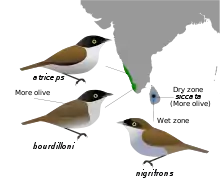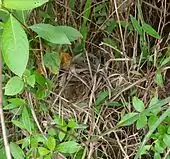Dark-fronted babbler
The dark-fronted babbler (Dumetia atriceps) is an Old World babbler found in the Western Ghats of India and the forests of Sri Lanka. They are small chestnut brown birds with a dark black cap, a whitish underside and pale yellow iris. They forage in flocks in the undergrowth of forests constantly making calls and uttering alarm calls when disturbed.
| Dark-fronted babbler | |
|---|---|
 | |
| Dumetia atriceps nigrifrons at Kanneliya Forest Reserve, Sri Lanka | |
| Scientific classification | |
| Kingdom: | Animalia |
| Phylum: | Chordata |
| Class: | Aves |
| Order: | Passeriformes |
| Family: | Timaliidae |
| Genus: | Dumetia |
| Species: | D. atriceps |
| Binomial name | |
| Dumetia atriceps (Jerdon, 1839) | |
 | |
| Synonyms | |
| |
Description
The dark-fronted babbler measures 13 cm including its square-tipped tail. It is brown above and white below. The two subspecies in the Western Ghats have black hoods, but the two Sri Lankan races have this reduced to a dark bandit mask. The pale yellow iris stands in contrast. The subspecies in the southern Western Ghats bourdilloni has a duller sooty-black hood, browner underside[2] and the upper parts are more olive. The nominate form found north of the Palghat Gap has the hood dark black. In Sri Lanka, the subspecies siccata is found in the lower elevation while nigrifrons is found in the wet zone. The former has more olive on the upperparts while the later is rufescent on the upperparts.[3]
It belongs to the subfamily Timaliinae and is a sister of the genus Dumetia.[4]
Behaviour and ecology

Babblers have a weak flight and are residents within their range. The forage in parties and clamber up vegetation and when disturbed, they tend to drop from the topmost perches of the bush into the undergrowth.[5] The typical habitat is undergrowth in forest or on the edge of forests in more open growth.[3] Their food is mainly insects. They can be difficult to observe in the dense vegetation they prefer, but like other babblers, these are noisy birds, and their characteristic rattling churr alarm calls are often the best indication that these birds are present.[6] They often join mixed-species foraging flocks.[7]
The breeding season is May to July. This babbler builds its nest low down in a bush, the nest being a ball of leaves, often of bamboo. The nest looks like some dry leaves stuck in a bush with the opening on the side.[8] The normal clutch is two eggs. They are also said to construct dormitory nests within which birds may sometimes roost. These dormitory nests are not lined.[9][10][11]
References
- BirdLife International (2012). "Rhopocichla atriceps". IUCN Red List of Threatened Species. 2012. Retrieved 26 November 2013.CS1 maint: ref=harv (link)
- Baker, EC Stuart (1922). Fauna of British India. Birds. Volume 1 (2nd ed.). Taylor and Francis, London. pp. 281–282.
- Rasmussen PC; JC Anderton (2005). Birds of South Asia: The Ripley Guide. Volume 2. Smithsonian Institution & Lynx Edicions. p. 441.
- Moyle, Robert G.; Andersen, Michael J.; Oliveros, Carl H.; Steinheimer, Frank D.; Reddy, Sushma (2012). "Phylogeny and Biogeography of the Core Babblers (Aves: Timaliidae)". Systematic Biology. 61 (4): 631–651. doi:10.1093/sysbio/sys027. PMID 22328569.
- Ali, S; Ripley SD (1996). Handbook of the Birds of India and Pakistan. Volume 6. New Delhi: Oxford University Press. pp. 183–185.
- Collar, N. J.; Robson, C. (2007). "Family Timaliidae (Babblers)". In del Hoyo, J.; Elliott, A.; Christie, D.A. (eds.). Handbook of the Birds of the World, Vol. 12. Picathartes to Tits and Chickadees. Lynx Edicions, Barcelona. pp. 70–291.
- Kotagama, SW; E Goodale (2004). "The composition and spatial organisation of mixed-species flocks in a Sri Lankan rainforest" (PDF). Forktail. 20: 63–70.
- Wait, WE (1922). "The Passerine birds of Ceylon". Spolia Zeylanica. 12: 48–49.
- Betts, FN (1935). "Nidification of the Blackheaded Babbler Rhopocichla a. atriceps (Oates)". J. Bombay Nat. Hist. Soc. 38 (1): 189.
- Whistler, Hugh (1949). Popular handbook of Indian birds (4th ed.). Gurney and Jackson, London. pp. 56–57.
- Bates, W (1934). "Nidification of the Travancore Laughing Thrush Trochalopteron jerdoni fairbanki (Blanf.) and the Black-headed Babbler Rhopocichla atriceps atriceps (Oates)". J. Bombay Nat. Hist. Soc. 37 (3): 727.

